MercoPress. South Atlantic News Agency
Tag: Argentine peso
-
Friday, June 22nd 2018 - 09:16 UTC
Stocks up 6% and the Peso stabilized following MSCI upgrade of Argentina
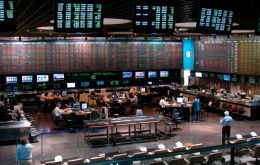
Argentine stocks surged on Thursday after index provider MSCI upgraded the country to its emerging markets index a day earlier, a respite from months of dismal economic news for market-friendly President Mauricio Macri. The local Merval stock index closed up 6%, led by industrials and banks. Investment bank Grupo Financiero Valores led gains, rising 18.3%, while aluminum producer Aluar rose 13%.
-
Tuesday, June 19th 2018 - 08:35 UTC
Argentina shores the Peso, stock market tumbles, ahead of 'Super Tuesday'

Argentina's peso rose sharply on Monday as a new central bank chief took his first moves to shore up the battered currency, while escalating fears of a damaging trade war between the United States and China drove Latin American stocks down. The Argentine peso jumped after the central bank said it will hike bank's reserve requirements in a move expected to tighten local-currency liquidity after the latest run on the peso.
-
Thursday, May 24th 2018 - 08:44 UTC
Dollar/Peso challenge: Argentina offers to swap one-month Lebacs for long term papers

Argentina’s central bank moved on Wednesday to improve its debt profile by offering to swap some of its one-month Lebac securities for paper of longer duration, the bank said in a statement.
-
Wednesday, May 9th 2018 - 20:19 UTC
US Dollar rises: Uruguay behind Argentina
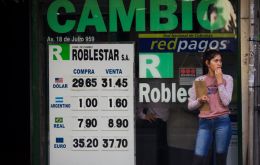
After several days up in Argentina, the devaluation of the Argentine peso and the rise of the US dollar have had some impact on the other side of the River Plate, where the exchange houses of downtown Montevideo marked on Wednesday the value of the currency up to 31,70 Uruguayan pesos per dollar, a rise of 2.08% compared to Monday —the highest in five years—. For the Uruguayan government, the country follows the global trend and calls for calm, beyond the noise generated in Argentina, which is beginning a dialogue between the Finance Minister, Nicolás Dujovne, and the International Monetary Fund (IMF) in Washington.
-
Tuesday, May 8th 2018 - 06:57 UTC
Argentine Peso: the worst of the storm seems to be over...for the time being

The Argentine Peso closed slightly weaker on Monday, though analysts remained optimistic the government and central bank had curbed a run on the currency with a massive rate hike and lower fiscal deficit target last week. . The local currency opened stronger on Monday but closed down 0.41%, at 21.97 per U.S. dollar. The Merval stock index ended down 3.43% and traders said investors remained cautious.
-
Monday, May 7th 2018 - 08:29 UTC
Argentina and China among the most vulnerable markets, says IIF

The markets of China, Ukraine, Argentina, South Africa and Turkey are the most vulnerable among all developing countries in terms of financing needs, reserve adequacy, asset valuation, institutional quality and trade resilience, according to a review by the analysts of the Institute of International Finance (IIF).
-
Friday, May 4th 2018 - 09:00 UTC
Argentine Peso tumbles 7.83% to US dollar; central bank raises rate to 33.25%
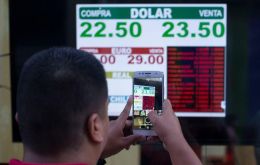
Argentina’s central bank raised its benchmark interest rate by 300 basis points to 33.25% percent on Thursday, but the second steep rate increase in less than a week failed to stop the country’s peso currency from swooning to a record low. The local currency tumbled 7.83% to 23 per U.S. dollar. It had hit 21.2 to the greenback on Wednesday, the first trading day due to a holiday after the bank hiked the rate to 30.25% from 27.25% on Friday.
-
Thursday, May 3rd 2018 - 08:39 UTC
Lack of investor confidence sees the Argentine Peso fall 3.11% against the dollar
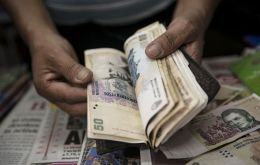
Argentina’s peso currency closed down 3.11% on Wednesday at an all-time low of 21.2 per U.S. dollar, even as the central bank continued selling dollars to try to halt the slide of the local currency, traders said. The currency’s sustained weakening showed a lack of investor confidence in Latin America’s third largest economy, which is blighted by one of the world’s highest inflation rates.
-
Wednesday, March 14th 2018 - 09:15 UTC
Argentina central bank leaves basic rate unchanged to combat inflation
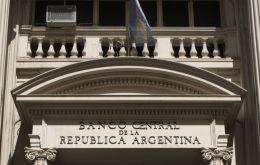
Argentina's central bank left the basic interest rate unchanged at 27.5%, a clear signal that inflation remains the main challenge of the country's monetary policy. The bank also revealed that last week it intervened in the local market with 400 million dollars to keep the US dollar in the range of 20/20,50 Pesos to the greenback.
-
Thursday, October 29th 2015 - 06:39 UTC
Argentina's dollar clamp intensifies following on Sunday's election results
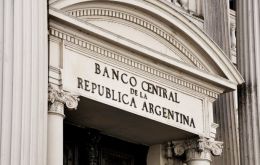
Argentina on Tuesday halved the daily amount of dollars companies can transfer abroad without authorization, currency traders said, while the country's insurance regulator put new limits on the amount of hard currency assets insurers can hold.
